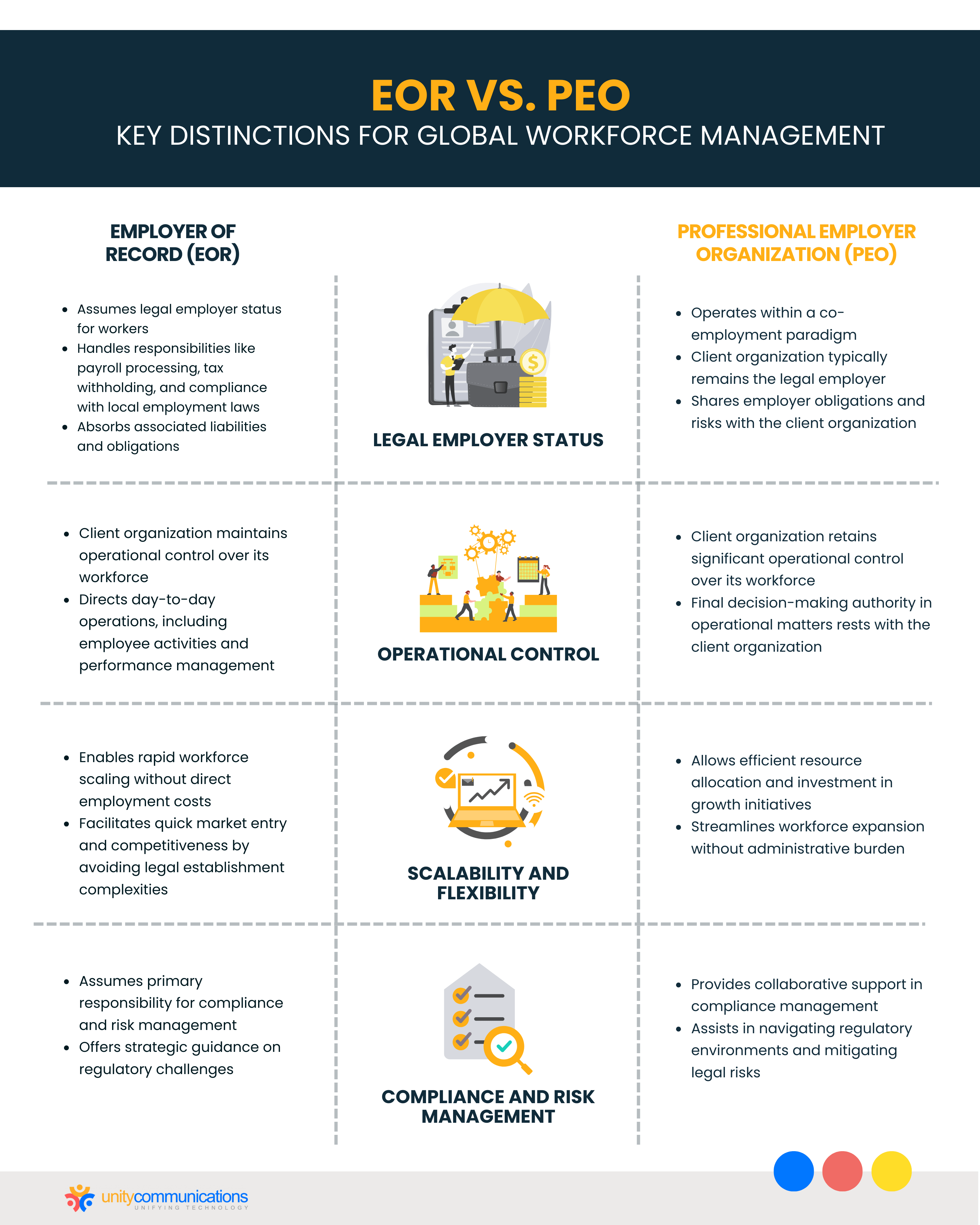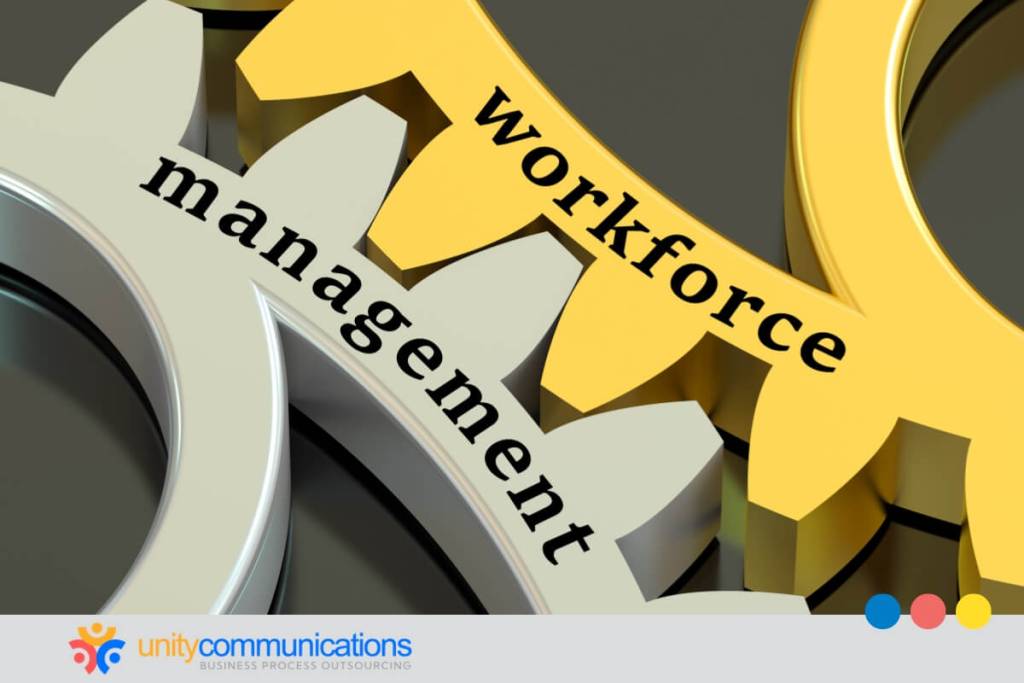Table of Contents
In global workforce management, understanding the distinctions between employer of record (EOR) services and professional employer organization (PEO) services is crucial for businesses to navigate the international employment law and optimize their operations.
The nuances between the employer of record and PEO are also necessary to make informed decisions that align with organizational objectives and compliance requirements.
This article discusses the fundamental differences between EOR and PEO services, highlighting their various roles for successful global labor management.
Keep reading to discover essential factors for making this pivotal business decision.
Employer of Record vs. PEO: Why Compare?

EOR and PEO are third-party providers offering two distinct solutions for workforce management. EORs assume legal employer status for workers, handling compliance and payroll tasks. Meanwhile, PEOs operate under a co-employment model and share responsibilities with client organizations.
One category of third-party provider offering EOR services is a business process outsourcing (BPO) company. It provides client companies with outsourced operations, including customer support, information technology (IT) assistance, and data entry services.
Contrasting these services to grasp their distinct attributes and identify the most suitable option for business requirements is essential. By comparing the employer of record against the PEO, businesses can make informed decisions to optimize workforce management strategies and achieve operational efficiency.
Four Crucial Aspects Differentiating Employer of Record From PEO

Explore the critical differences between EOR and PEO services across four key aspects: legal employer status, operational control, scalability and flexibility, compliance, and risk management.
1. Legal Employer Status
The distinction between EOR and PEO services regarding legal employer status is pivotal in understanding their respective roles and implications for businesses.
Under an EOR agreement:
- The third-party organization takes on the legal employer status for workers in a specific jurisdiction.
- The EOR becomes the official employer on record, shouldering responsibilities such as payroll processing, tax withholding, and compliance with local employment laws.
- The EOR service provider absorbs associated liabilities and obligations, providing businesses with a streamlined solution for global expansion.
- EOR services enable businesses to establish a presence in new markets without setting up legal firms in each jurisdiction, fostering agility and compliance.
When employing a PEO:
- Services follow a co-employment paradigm in which the client organization and the PEO share particular employer obligations and risks.
- While the PEO facilitates human resources (HR) functions such as payroll administration and benefits management, the client organization typically remains the legal employer.
- PEOs act as strategic HR partners that provide comprehensive personnel outsourcing solutions while sharing employer responsibilities, including compliance with employment laws.
Key differences in legal employer status:
- EORs directly assume legal employer status, alleviating businesses from administrative burdens and legal complexities associated with global workforce management.
- PEOs function within a co-employment framework, where the client organization maintains legal employer status while sharing specific HR responsibilities with the PEO.
- The distinction lies in allocating legal liabilities and obligations, with EORs bearing full responsibility and PEOs sharing duties with the client organization.
2. Operational Control
Understanding the operational control of the employer of record compared to the PEO is critical in selecting between these two services. Let us check the comparison below.
In an EOR arrangement:
- The third-party company assumes legal employer status, while the client organization maintains operational control over its workforce.
- The client organization retains authority over day-to-day operations, including directing employee activities, enforcing policies, and managing workforce performance.
- Operational supervision covers hiring, training, performance appraisal, disciplinary measures, and other personnel management aspects.
- This autonomy allows the client organization to align operational decisions with strategic objectives and corporate culture.
In a PEO setup:
- The client organization exercises authority in decision-making processes related to staffing, project assignments, and organizational structure.
- While the PEO facilitates HR functions such as payroll administration and benefits management, the client organization retains significant operational control over its workforce.
- Despite leveraging PEO expertise, the client organization maintains the final say in operational matters, ensuring alignment with its business objectives.
Key differences in operational control:
- In EOR arrangements, the client organization directly manages day-to-day operations and workforce activities, whereas PEO services entail shared responsibility, and ultimate control remains with the client.
- EORs provide a streamlined solution for global expansion without relinquishing operational control, whereas PEOs offer comprehensive HR outsourcing while maintaining client oversight.
- EORs foster a collaborative partnership wherein the client organization retains autonomy, while PEOs act as strategic HR partners with shared responsibilities.
3. Scalability and Flexibility
Assessing the scalability and flexibility of employer of record and PEO services is crucial for businesses aiming to adapt to dynamic market conditions and expand their global footprint efficiently.
When utilizing EOR services:
- BPO firms offering IT support outsourcing, customer service, and similar delegated processes ensure compliance across jurisdictions, reducing legal risks and enabling market expansion while ensuring regulatory adherence.
- EOR providers enable rapid workforce scaling, optimizing efficiency without direct employment and overhead costs and responding to market demands.
- EORs offer quick market entry, fostering competitiveness and growth by avoiding the complexities of legal establishment.
In the context of PEO:
- Third-party organizations offer scale, cutting HR budgets or costs and allowing efficient resource allocation and investment in growth initiatives.
- PEOs provide full HR outsourcing, boosting scalability by streamlining workforce expansion without administrative burden.
- Non-affiliated partners widen talent access, enhancing scalability by fast-tracking recruitment and fostering organizational agility in markets.
Key differences in scalability and flexibility:
- EORs facilitate market entry without establishing legal firms for rapid scalability, while PEOs provide comprehensive HR support to simplify workforce expansion without administrative burden.
- EOR ensures legal compliance and mitigates risks for market expansion, whereas PEO emphasizes HR support and talent acquisition for enhanced scalability.
- EOR provides tailored solutions to fulfill business requirements while matching organizational goals and market conditions. In contrast, PEO offers customized HR support, allowing flexibility in adjusting personnel management tactics to changing company requirements.
4. Compliance and Risk Management
How vital are employer of record and PEO services in compliance and risk management for businesses operating in diverse jurisdictions? Very! Understanding the differences between the two can help enterprises navigate complex regulatory landscapes and mitigate legal risks effectively.
In an EOR framework:
- The BPO vendor assumes legal employer status for workers, shouldering primary responsibility for compliance and risk management.
- EOR protects businesses from legal disputes and penalties by assuming primary liability for employment-related issues.
- The service provider offers strategic guidance on compliance matters, ensuring businesses navigate regulatory challenges effectively.
- Third-party vendors specialize in complying with local employment laws and regulations across multiple jurisdictions, ensuring regulatory adherence.
Within the scope of PEO operations:
- The service provider offers comprehensive HR support, leveraging expertise to navigate complex regulatory environments and mitigate legal risks effectively.
- The third-party organization provides collaborative support in compliance management, allowing businesses to adapt to changing regulatory environments effectively.
- The non-affiliated partner assists businesses in expanding their operations by guiding compliance and risk management in new markets.
Key differences in compliance and risk management:
- EORs take on legal employer status, primarily handling compliance and risk, while PEOs share employer responsibilities with clients.
- EORs manage most employer duties and risks for streamlined compliance, while PEOs collaborate with clients on HR and compliance.
- EORs ensure compliance with local laws across jurisdictions, while PEOs provide HR support to navigate regulatory complexities and mitigate risks.
The Bottom Line

The distinctions between employer of record and PEO services are critical for businesses seeking to optimize their global workforce management strategies and drive sustainable growth.
The decision between EOR and PEO services ultimately depends on each organization’s needs, preferences, and goals. As such, companies must thoroughly examine legal consequences, operational controls, and compliance needs.
Let’s connect if you want to learn more about employer of record and PEO services and delve deeper into their distinctions and implications for your business.




